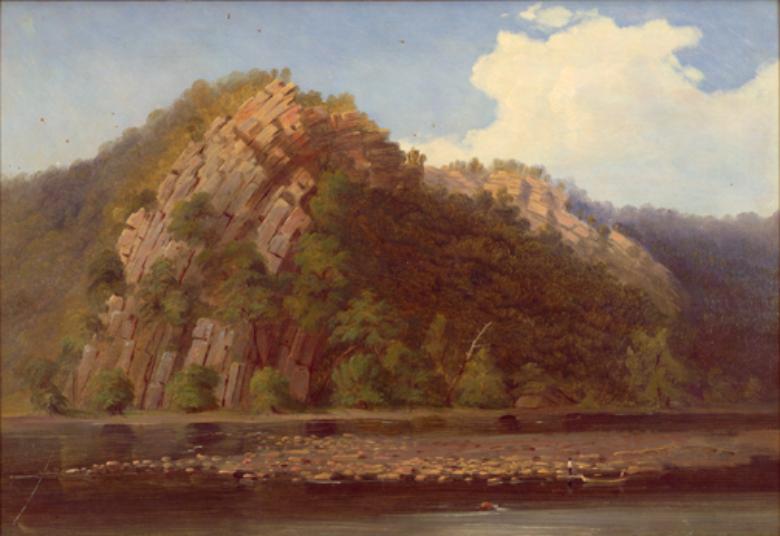Virginia Geological Survey, Records, 1834-1903. Accession 24815, State Government Records Collection
52 sketches. Pencil, ink, watercolor, pastel, and oil on paper and cardboard. Dimensions: Vary from 11 11/16 x 7 11/16 in. to 23 9/16 x 18 1/8 in.
Visual Studies Collection.
1 sketch. Watercolor on paper. Dimensions: 12 5/8 x 8 ½ in.
One hundred and seventy-five years ago this summer, William Barton Rogers and William Thompson Russell Smith boarded a train in Pennsylvania bound for Washington, D.C. Their ultimate destination was the western part of Virginia, where they intended to describe and document geological features. Rogers (1804-1882), a geologist, chemist, physicist, and professor at the University of Virginia, had begun work on a geological survey of Virginia in 1835. Although funding from the General Assembly ceased in 1842, Rogers believed a final report would eventually be authorized. He hired Smith, an artist he had worked with on previous geological publications, to illustrate this final report.
William Thompson Russell Smith (1812–1896), better known as Russell Smith, was born in Glasgow, Scotland. His father brought the family to rural Pennsylvania in 1819 before moving to the growing town of Pittsburgh to be near schools. After studying with the portrait artist James Lambdin, Smith began developing a reputation as a theatrical scene painter and commercial artist. His lifelong affection for landscape painting and his work in scientific illustration both prepared him for his travels with Rogers.
The men’s first stop was in Charlottesville and the surrounding countryside. On July 9, Smith sketched a scene from Edgehill, the home of Colonel Jefferson Randolph (a grandson of Thomas Jefferson). In the journal he kept of the trip, Smith wrote, “Mr. Randolph’s lawn commands a fine view of the Blue Ridge and Montocello [sic] and the Rivana [sic] River winds beautifully in the middle distance.”
Most of the sketches are simple drawings in pencil or ink. It appears that Smith initially believed he would be able to do more elaborate illustrations, but the realities of the trip intervened. He explained to his wife, “I never have time to paint for we travel almost constantly and outlines are all that I can make and they too are often very hasty for an hour’s delay would sometimes through [sic] us out of a nights lodging in this thinly settled country.” He would sometimes make sketches during the day and then retouch them in the evening, trying to capture the light and shading with washes.
While Smith judged the Virginia landscapes inferior to those of his home in Pennsylvania, he did find some artistic inspiration. On July 16, 1844, Smith and Rogers entered what was then known as Weyer’s Cave (now Grand Caverns, Grottoes, Virginia). Smith described the scene: “[H]ere a million new forms and arrangements delicate, brilliant massive and sublime meet you at every turn becoming gloomy and misterious [sic] or gorgeous and splendid with every change of the torches.” Despite the difficulty of working in the cold, dark, and damp environment, he would create many sketches of the cave’s “rooms.”
Rogers and Smith finished their trip by the autumn of 1844 and parted ways. Smith would use many of his sketches as the basis for landscape paintings, including three now in the collection of Virginia’s Executive Mansion. Rogers maintained hope that the General Assembly would find the money to publish his geological survey, and he held onto the survey records and sketches until his death. His widow donated his papers, including works by Smith, to the Library in 1903. The Visual Studies Collection acquired the other Weyer’s Cave watercolor in 2018.

Arrangement and access: Patrons may access the Virginia Geological Survey Records (Acc. 24815) at the Library’s second floor Archives Manuscripts Room, open Monday-Saturday, 9 am – 4:30 pm.
The finding aid for that collection, including a detailed list of the 52 sketches, may be viewed here.
The watercolor in the Visual Studies Collection may be accessed by visiting the Special Collections Reading Room, open Monday-Friday, 1-4:30 pm. Special Collections also has inkjet copies of the other 52 sketches available for researchers.
References: Excerpts from Russell Smith’s journal and letters are taken from
Lewis, Virginia E. Russell Smith, Romantic Realist. Pittsburgh: University of Pittsburgh Press, 1957. Print.

